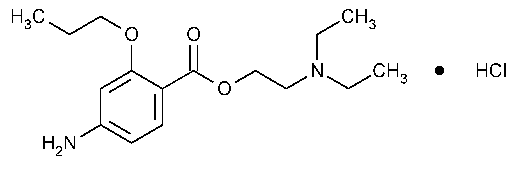Propoxycaine Hydrochloride
Benzoic acid,4-amino-2-propoxy-,2-(diethylamino)ethyl ester,monohydrochloride.
2-(Diethylamino)ethyl 4-amino-2-propoxybenzoate monohydrochloride [550-83-4].
»Propoxycaine Hydrochloride,dried at 105 for 3hours,contains not less than 98.0percent and not more than 102.0percent of C16H26N2O3·HCl.
for 3hours,contains not less than 98.0percent and not more than 102.0percent of C16H26N2O3·HCl.
Packaging and storage—
Preserve in well-closed,light-resistant containers.
Identification—
A:
Infrared Absorption á197Kñ.
B:
Ultraviolet Absorption á197Uñ—
Solution:
10µg per mL.
Medium:
water.
Absorptivities at 303nm,calculated on the dried basis,do not differ by more than 3.0%.
C:
Dissolve about 100mg in 10mLof water,heat almost to boiling,and add,with stirring,1mLof a saturated solution of trinitrophenol in 20percent alcohol.Cool slowly,collect the precipitate on a filter,wash with a few small portions of water,and dry in a vacuum desiccator over phosphorus pentoxide for 18hours:the picrate so obtained melts between 130 and 138
and 138 ,with decomposition (see Melting á741ñ).[Caution—Picrates may explode.
]
,with decomposition (see Melting á741ñ).[Caution—Picrates may explode.
]
D:
Asolution (1in 100)responds to the tests for Chloride á191ñ.
Loss on drying á731ñ—
Dry it at 105 for 3hours:it loses not more than 0.5%of its weight.
for 3hours:it loses not more than 0.5%of its weight.
Residue on ignition á281ñ:
not more than 0.2%.
Chromatographic purity—
Solvent—
Prepare a mixture of chloroform and methanol (9:1).
Standard preparations—
Dissolve a quantity of USP Propoxycaine Hydrochloride RSin Solvent,and dilute quantitatively,and stepwise if necessary,with Solventto obtain a solution containing 0.5mg per mL.Dilute quantitatively with Solventto obtain Standard preparations having the following compositions:
| Standard preparation |
Dilution | Concentration (mg RSper mL) |
Percentage (%, for comparison with test specimen) |
| A | 1in 2 | 0.25 | 0.5 |
| B | 1in 5 | 0.10 | 0.2 |
| C | 1in 10 | 0.05 | 0.1 |
Test preparation—
Dissolve an accurately weighed quantity of Propoxycaine Hydrochloride in Solventto obtain a solution containing 50mg per mL.
Procedure—
Apply separately 5µLof the Test preparationand 5µLof each Standard preparationto a suitable thin-layer chromatographic plate (see Chromatography á621ñ)coated with a 0.25-mm layer of chromatographic silica gel mixture.Position the plate in a chromatographic chamber,and develop the chromatograms in a solvent system consisting of a mixture of chloroform,methanol,and isopropylamine (96:2:2)until the solvent front has moved about three-fourths of the length of the plate.Remove the plate from the developing chamber,mark the solvent front,and allow the solvent to evaporate,with the aid of warm circulating air.Examine the plate under short-wavelength UVlight,and again after exposing the plate to iodine vapors for a few minutes and spraying it with 7Nsulfuric acid.In each instance,compare the intensities of any secondary spots observed in the chromatogram of the Test preparationwith those of the principal spots in the chromatograms of the Standard preparations:no secondary spot is more intense than the principal spot obtained from Standard preparation A(0.5%),and the sum of the intensities of all secondary spots obtained from the Test preparationdoes not exceed 1.0%.
Assay—
Dissolve about 500mg of Propoxycaine Hydrochloride,previously dried and accurately weighed,in 200mLof ice-cold water containing 1g of potassium bromide and 2.5mLof hydrochloric acid,and titrate with 0.1Msodium nitrite VS,using starch iodide paper as an external indicator.Perform a blank determination,and make any necessary correction.Each mLof 0.1Msodium nitrite is equivalent to 33.09mg of C16H26N2O3·HCl.
Auxiliary Information—
Staff Liaison:Karen A Russo,Ph.D.,Scientist
Expert Committee:(PA1)Pharmaceutical Analysis 1
USP28–NF23Page 1648
Pharmacopeial Forum:Volume No.29(5)Page 1567
Phone Number:1-301-816-8379
